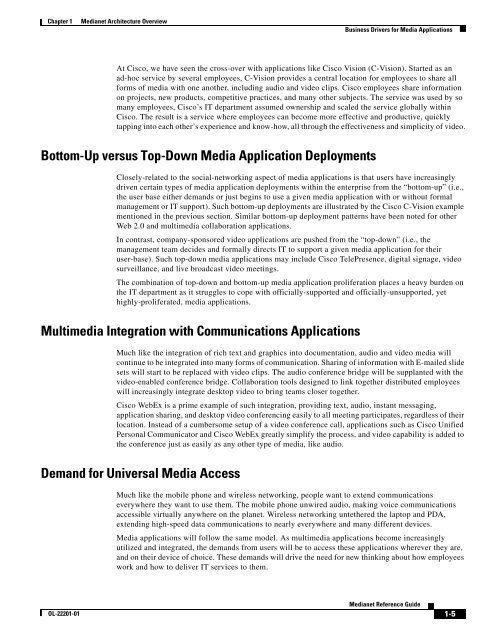Medianet Reference Guide - Cisco
Medianet Reference Guide - Cisco
Medianet Reference Guide - Cisco
Create successful ePaper yourself
Turn your PDF publications into a flip-book with our unique Google optimized e-Paper software.
Chapter 1<br />
<strong>Medianet</strong> Architecture Overview<br />
Business Drivers for Media Applications<br />
At <strong>Cisco</strong>, we have seen the cross-over with applications like <strong>Cisco</strong> Vision (C-Vision). Started as an<br />
ad-hoc service by several employees, C-Vision provides a central location for employees to share all<br />
forms of media with one another, including audio and video clips. <strong>Cisco</strong> employees share information<br />
on projects, new products, competitive practices, and many other subjects. The service was used by so<br />
many employees, <strong>Cisco</strong>’s IT department assumed ownership and scaled the service globally within<br />
<strong>Cisco</strong>. The result is a service where employees can become more effective and productive, quickly<br />
tapping into each other’s experience and know-how, all through the effectiveness and simplicity of video.<br />
Bottom-Up versus Top-Down Media Application Deployments<br />
Closely-related to the social-networking aspect of media applications is that users have increasingly<br />
driven certain types of media application deployments within the enterprise from the “bottom-up” (i.e.,<br />
the user base either demands or just begins to use a given media application with or without formal<br />
management or IT support). Such bottom-up deployments are illustrated by the <strong>Cisco</strong> C-Vision example<br />
mentioned in the previous section. Similar bottom-up deployment patterns have been noted for other<br />
Web 2.0 and multimedia collaboration applications.<br />
In contrast, company-sponsored video applications are pushed from the “top-down” (i.e., the<br />
management team decides and formally directs IT to support a given media application for their<br />
user-base). Such top-down media applications may include <strong>Cisco</strong> TelePresence, digital signage, video<br />
surveillance, and live broadcast video meetings.<br />
The combination of top-down and bottom-up media application proliferation places a heavy burden on<br />
the IT department as it struggles to cope with officially-supported and officially-unsupported, yet<br />
highly-proliferated, media applications.<br />
Multimedia Integration with Communications Applications<br />
Much like the integration of rich text and graphics into documentation, audio and video media will<br />
continue to be integrated into many forms of communication. Sharing of information with E-mailed slide<br />
sets will start to be replaced with video clips. The audio conference bridge will be supplanted with the<br />
video-enabled conference bridge. Collaboration tools designed to link together distributed employees<br />
will increasingly integrate desktop video to bring teams closer together.<br />
<strong>Cisco</strong> WebEx is a prime example of such integration, providing text, audio, instant messaging,<br />
application sharing, and desktop video conferencing easily to all meeting participates, regardless of their<br />
location. Instead of a cumbersome setup of a video conference call, applications such as <strong>Cisco</strong> Unified<br />
Personal Communicator and <strong>Cisco</strong> WebEx greatly simplify the process, and video capability is added to<br />
the conference just as easily as any other type of media, like audio.<br />
Demand for Universal Media Access<br />
Much like the mobile phone and wireless networking, people want to extend communications<br />
everywhere they want to use them. The mobile phone unwired audio, making voice communications<br />
accessible virtually anywhere on the planet. Wireless networking untethered the laptop and PDA,<br />
extending high-speed data communications to nearly everywhere and many different devices.<br />
Media applications will follow the same model. As multimedia applications become increasingly<br />
utilized and integrated, the demands from users will be to access these applications wherever they are,<br />
and on their device of choice. These demands will drive the need for new thinking about how employees<br />
work and how to deliver IT services to them.<br />
OL-22201-01<br />
<strong>Medianet</strong> <strong>Reference</strong> <strong>Guide</strong><br />
1-5







